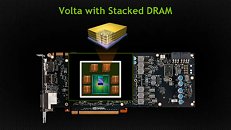- Joined
- Oct 9, 2007
- Messages
- 47,648 (7.44/day)
- Location
- Dublin, Ireland
| System Name | RBMK-1000 |
|---|---|
| Processor | AMD Ryzen 7 5700G |
| Motherboard | Gigabyte B550 AORUS Elite V2 |
| Cooling | DeepCool Gammax L240 V2 |
| Memory | 2x 16GB DDR4-3200 |
| Video Card(s) | Galax RTX 4070 Ti EX |
| Storage | Samsung 990 1TB |
| Display(s) | BenQ 1440p 60 Hz 27-inch |
| Case | Corsair Carbide 100R |
| Audio Device(s) | ASUS SupremeFX S1220A |
| Power Supply | Cooler Master MWE Gold 650W |
| Mouse | ASUS ROG Strix Impact |
| Keyboard | Gamdias Hermes E2 |
| Software | Windows 11 Pro |
Following the surprise TITAN X Pascal launch slated for 2nd August, it looks like NVIDIA product development cycle is running on steroids, with reports emerging of the company accelerating its next-generation "Volta" architecture debut to May 2017, along the sidelines of next year's GTC. The architecture was originally scheduled to make its debut in 2018.
Much like "Pascal," the "Volta" architecture could first debut with HPC products, before moving on to the consumer graphics segment. NVIDIA could also retain the 16 nm FinFET+ process at TSMC for Volta. Stacked on-package memory such as HBM2 could be more readily available by 2017, and could hit sizable volumes towards the end of the year, making it ripe for implementation in high-volume consumer products.

View at TechPowerUp Main Site
Much like "Pascal," the "Volta" architecture could first debut with HPC products, before moving on to the consumer graphics segment. NVIDIA could also retain the 16 nm FinFET+ process at TSMC for Volta. Stacked on-package memory such as HBM2 could be more readily available by 2017, and could hit sizable volumes towards the end of the year, making it ripe for implementation in high-volume consumer products.

View at TechPowerUp Main Site






